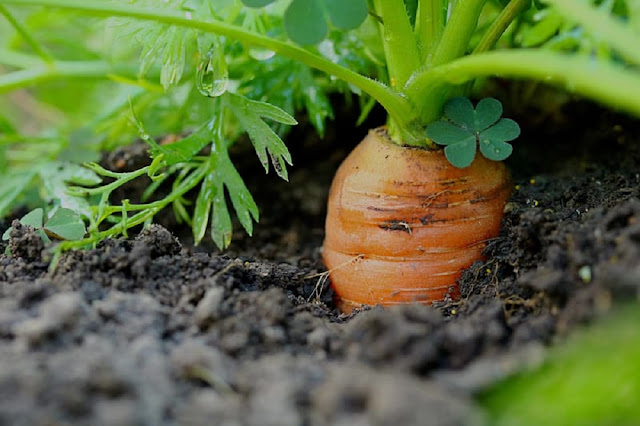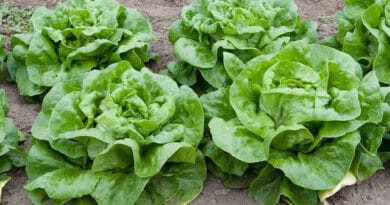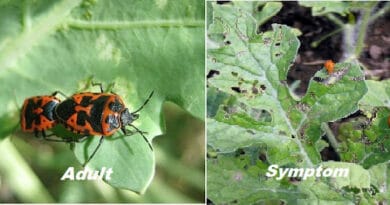Cultivation of Carrrot
The carrot (Dancus carota) belongs to the family Umbelliferae. It is a winter-season root crop and is grown all over India. It is used for consumption as forage, particularly for feeding the horses. It is taken raw and also used to prepare curries, and used for pickles and sweets. It is a rich source of carotene, a precursor of Vitamin A, and contains appreciable quantities of thiamin and riboflavin.
Nutritive Value of Carrot ;
The nutritive value of a carrot in 100 g of the edible portion is given below:
| Serving Size 100 g | %DV | |
| Calories | 41 kcal | 0% |
| Total Carbohydrate | 10 g | 3% |
| Dietary Fiber | 2.8 g | 9.00% |
| Sugar | 4.7 g | |
| Protein | 0.9 g | 0% |
| Cholesterol | 0 | 0% |
| Saturated fat | 0 | 0% |
| Sodium | 69 mg | 0% |
| Potassium | 320 mg | 3% |
| Iron | 1% | |
| Calcium | 3% | |
| Vitamin C | 9% | |
| Vitamin B6 | 5% | |
| Magnesium | 3% | |
| Vitamin D | 0% | |
| Cobalamin | 0% | |
| *Percent Daily Values are based on a 2,000-calorie diet. Your daily values may be higher or lower depending on your calorie needs. | ||
Climate Requirement for the Cultivation of Carrot ;
The carrot is a Winter-season crop. The color, growth, and development of roots affected by temperature. Carrots which has grown at 10 to 15°C develop a poor color, and those grown at 15°C to 20°C will develop good color. Carrots that have grown at higher temperatures become shorter and thicker. The Longest and most slender roots are produced at the lowest temperature of 10°C to 15°C.
Soil and its preparation for Carrot cultivation;
The carrot grows well in well-drained, deep, loose, and loamy soil. Looseness of soil gives good, round-shaped roots and a higher yield. The maximum yield is expected at soil pH 6.5.
Carrot requires loose and deep seedbeds for their development. The soil is brought to a fine tilth by giving 6-8 ploughings followed by planking after each ploughing.
Varieties of Carrot;
Type | Varieties | Variety Characteristics |
Tropical | Pusa Vrishti | High heat and humidity tolerant tropical carrot. Obtriangular in shape with light purple pigmentation on shoulders and self-red color,90-95 days for harvesting, Av. Root weight 150 – 200 gms, 250 q/hac av. yield. Suitable for cultivation in NCT |
Tropical | Pusa Kesar | Developed at the IARI, New Delhi. It has red-colored roots and a self-colored core. It can tolerate higher temperatures. Suitable for sowing from August – early October. The crop matures in 90-110 days with an average yield of 30 t/ha. |
Tropical | Pusa Meghali | Developed at IARI, New Delhi; has orange flesh, a self-colored core, and a short top. Suitable for sowing from August to September. The average yield is 25-30 t/ha. |
Tropical | Selection 223 | Developed by PAU, Ludhiana. Roots are orange in color with light orange flesh. |
Tropical | No.2 9 | Developed by PAU, Ludhiana. Roots are long tapering and light red. |
Tropical | Kashi Krishna | Attractive black self-core color roots, tolerant to bolting, fewer secondary roots/scars, suitable for salad, juice, halwa, kanji (fermented juice) and nutraceutical purpose, a rich source of anthocyanin (285 mg/100gFW), phenolics and antioxidants, root yield (20-22 t/ha). S/rate: 4-5 kg/ha. |
Temperate Types | Nantes Half | Long It has cylindrical stumpy roots, orange-scarlet with a self-colored core, and crop matures in 110-120 days. |
Temperate Types
| Early Nantes | It is a European cultivar. Almost cylindrical roots terminate abruptly in small thin tails. Excellent quality but has a weak brittle top which makes pulling difficult. Due to thin skin and fine texture, it can be stored for a limited period. The crop matures within 90-100 days. |
Temperate Types
| Chantenay | It is an excellent cultivar for canning and storage. Roots are attractive orange smooth, thick at the shoulders with gradual tapering. It is more juicy with less fiber content. |
Temperate Types
| Imperator | It is a mid-season to late-maturing cultivar with white deep orange roots. Roots are 15-17.5 cm long and 2.4-4.5 cm in diameter with tapering to a slightly rounded end. |
Temperate Types
| Zeno | Zeno is Popular in Nilgiri hills, high yielding, and famous for its quality and flavor. |
Temperate Types
| Pusa Yamdagini | Developed at RRS, Katrain. It has orange flesh with a self-colored core. The crop matures early by 7-10 days then Early Nantes |
Exotic Varieties;
USA; Processing purpose, Red Cored Chantenay, Danvers Half Long, Imperator.
New Zealand; Akaroa Long Red, Spring Market Improved, Wanganui Giant
Japan ;Suko ;
Belgium; Belgian White
France; Chantenay, Nantes, Oxheart, Touchon
Australia: Red Elephant, Western Red, Yellow
Netherlands; Early Horn
Sowing of seeds
(a) Time of sowing.
Plains Sowing: Carrot is sown from the middle of August to the beginning of December
Hills Sowing: Can be Sown from March to the end of July in the hills.
- Desi type; can be sown up to October from August onwards
- European Types: The best time of sowing for European types is between September and November.
Several successive sowing, with an interval of 2-4 weeks helps to get a continuous supply.
(b) Seed rate. The normal seed rate is 2.0-2.5 kg per acre. The recommended 2.0 kg per acre of seeds for both Desi and European types.
(c) Method of sowing. Carrot is raised by seed. The seeds are sown on ridges or in flatbeds about 1.5 cm deep. They may be sown by broadcast or in small furrows, mixed with coarse sand or fine soil. Seeds sown on ridges produce a higher yield. The highest total and commercial yields were obtained from 20 x 10 cm spacing. The seeds are covered with soil after sowing. Carrot seeds take about a week 10 germinate.
Manuring Required for the cultivation of Carrot;
A carrot crop yielding about 112-120 quintals per acre removes 13 kg of Nitrogen, 75 kg of Phosphoric acid, and 40 kg of Potassium
Apply 40 kg of Nitrogen, 20 kg of Phosphorus, and 20 kg of Potassium per acre. or a fertilizer mixture of 32 kg of Nitrogen, 32 kg of Phosphorus, and 16 kg of Potassium is recommended
Application of F.Y.M. one month before sowing and a split application of N, P, and K at 24 kg each per acre to get a higher yield.
Before sowing carrot seeds, soak at 0.04 percent MnSO4, 0.02 percent of boric acid or 0.04 percent of Copper nitrate for two hours
Intercultural Operation
A carrot grows slowly at the seedling stage. So the removal of weeds is quite essential, especially at an earlier stage. Certain weedicides are quite effective in controlling the weeds in a carrot field. Chloroxuron @ 1.35 kg per acre and Linuron @ 0.23 to 0.45 kg per acre effectively controlled weeds.
Afalon applied as a pre-emergence weedicide @ 1.0 kg per acre gave good control of broadleaf weed. The soil should be hoed from time to time to allow proper aeration. At the second weeding, thinning in thick sown plants should be done to keep them 5.0 to 7.5 cm (plant to plant) spacing for their proper development.
Irrigation Requirement for the Cultivation of Carrot ;
Carrot needs sufficient moisture in the soil throughout its life cycle. Insufficient moisture in the soil may decrease the yield. Carrots should be irrigated before any wilting of leaves takes place. The carrot should not be irrigated heavily. Because it will result in excessive foliage growth, poor growth, poor quality roots, and maturity will be delayed.
The first irrigation is just after sowing and subsequent irrigation can be started four to six days after germination. Sprinkling irrigation greatly improved the germination and cut down on water requirement by 20 percent and increased the yield.
Pest and Disease Control in Carrot;
Pest control in Carrot Crop
Insect – Pest | Symptom | Control |
Silver Leaf- White Fly | The silverleaf whitefly feeds on plants by piercing the phloem or lower leaf surfaces with its mouth and removing nutrients. Affected areas may develop chlorotic spots, whither, or drop leaves. | Whiteflies can be difficult to control with insecticides. Most less-toxic products such as insecticidal soaps, neem oil, or petroleum-based oils control only those whiteflies that are directly sprayed |
Carrot Rust Fly | Damage is caused by larvae burrowing into the taproot. Young plants wilt and may die, but more often the plants are stunted temporarily and the carrots become bulbous, forked, and unmarketable. In addition, fungi and bacteria may invade the damaged tissue and cause severe rot at the crowns of the plants. | Deep ploughing and stirring of Soil, flooding of fields so that caterpillars are exposed to birds and other enemies. Hand-picking and destruction of caterpillars found just under the damaged plant. Soil application (drenching) of chlorpyriphos @ 0.1 percent. Poison baits containing wheat bran + carbaryl + molasses be spread on the ground to attract and kill larvae and Mixing of insecticidal dust
|
Carrot Weevil | Carrot weevil females overwinter in the soil and plant debris and lay their eggs in cavities in the crown of the carrots. These eggs develop hatch into larvae and feed on the carrot root. Feeding damage from the carrot weevil larvae causes unmarketable tunneling near the crown of the carrot and can account for significant losses to commercial growers | – Spray lambda-cyhalothrin@34 ml/hac ( first spray at a 2-3-leaf stage when insects or damage appear and spray till the threshold arrives). – Apply novaluron @166-332 ml /acre hac ( first spray at a 2-3-leaf stage when insects or damage appear and spray till the threshold arrived). |
Flea Beetle | Irregular-shaped cavities along the length of the taproot of carrot. A trail of tiny feeding sites can sometimes be visible by traveling down the length of the carrot | – Follow the early planting -use of insecticidal soaps or oils such as neem or canola oil etc |
Disease Control of Carrot;
Disease | Symptom | Control |
Cercospora Leaf Blight | Severe blighting on carrot leaves and petioles can be seen if wet weather conditions are longer during the growing season The whole leaves and petioles may die on severely infected carrot plants. The symptoms can be first observed along the margins of the leaves, often causing the leaves to curl. Spots inside the leaf edges are small, roughly circular, and tan or gray to brown with an almost dead center. | Two to three years of crop rotation is recommended. Apply Foltaf (0.2%) and copper Oxychloride (0.3%), when the first sign of infection appears
|
Alternaria Blight | leaf spots can be seen at the margin of the leaflets are darkish brown to black and are irregular in shape. The Lesions produced on the petioles and stems are dark brown and often coalesce and girdle the stems. These spots are more prevalent on older foliage and plants than on young foliage | – hot water treatment of the seeds at 50°C for 15 minutes is recommended. – Treat the seeds with Thiram (3g/kg of seed) before sowing. – apply Foltaf (0.2%) and copper Oxychloride (0.3%) for the effective control of disease |
Powdery Mildew | The symptoms visible as white powdery growth on the leaves and petioles. Due to which leaves to turn brown and wilt. | Apply the Bavistin (0.1%) or Benlate (0.1%) at an interval of 8-10 days for the effective control of the powdery mildew |
Watery soft Rot | white mold appears with an black sclerotia on the crown of infected carrots. During the carrot storage, a soft, watery rot with white mold and black sclerotia characterizes the disease. This disease more appers in the late sowing crop and during the storage of the carrot | This disease can be control by the Crop rotation and the weed control (to improve air circulation),Other factors are planting of carrot on raised beds, winter flooding, rapid cooling before the storage and proper sanitation of stores are necessary to reduce losses from this disease. |
Black Rot | This is a seed and soil-borne disease and is characterized by a shiny black decay at the crown area and a greenish-black mold on the taproot. The infected tissue of the root became greenish-black to jet-black due to the black spore masses. This disease may appear roots in the field as well as in storage | sanitation of the field and adopting the crop rotation helps to keep the disease under control. The root surface should kept dry and stored at 0 C with 95 % relative humidity |
Bacterial soft Rot | This disease appears due to wet field conations and improper storage. Soft water-soaked, irregular lesions are visible on the roots. These lesions are superficial but fast spread to cover the inner tissues. The leaves may remain green until the disease on the tuber advances considerably. The whole of the plant gets wilts under the complete rotting of the tuber. A foul smell is given out from the decayed roots. High moisture on the root surface favors disease incidence chances | Planting on raised beds in poorly drained areas should be followed Careful harvest handling, grading, and sanitation are the only ways to reduce the infection chances. The diseased roots should be avoided to be stored along with the healthy tubers. The root surface should kept dry and stored at 0 C with 95 % relative humidity |
Harvesting of the carrot crop ;
When the roots of the carrot are 2.5 to 3.7 cm in diameter at the upper end. they may be harvested. They are normally harvested, when the soil is sufficiently moist, with a spade or khurpi after removing the tops, which are close to the ground. The roots are trimmed and washed in water, and then they are sent to the market.
Storage
Carrots may remain fairly fresh for 3-4 days at ordinary temperature, could be stored only at 12°C for a long period without loss of quality. It can be stored in cold storage at 33°F to 40°F with 93 to 98 percent relative humidity.
Read Further;
Cultivation of Radish (Raphanus sativus L. )
Cultivation of Drumstick /Moringa ; The Tree of Life



